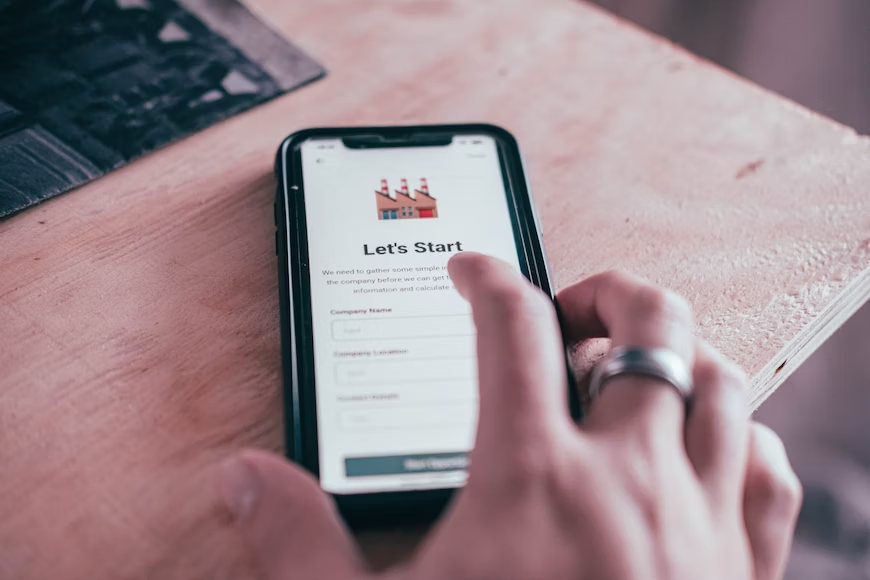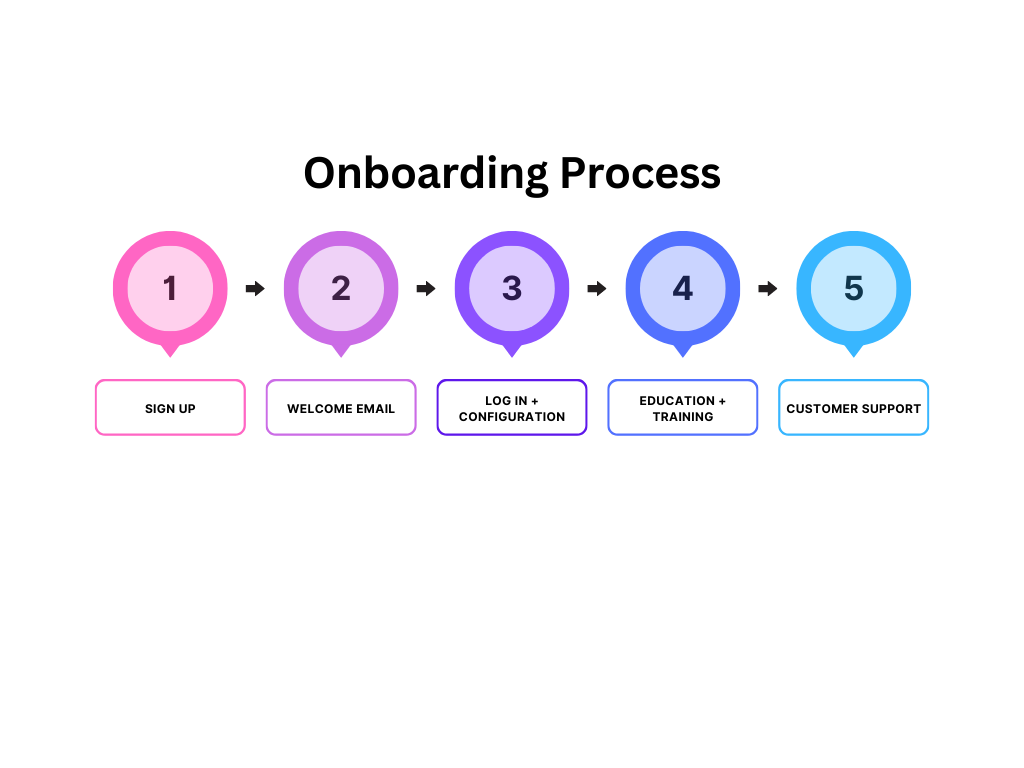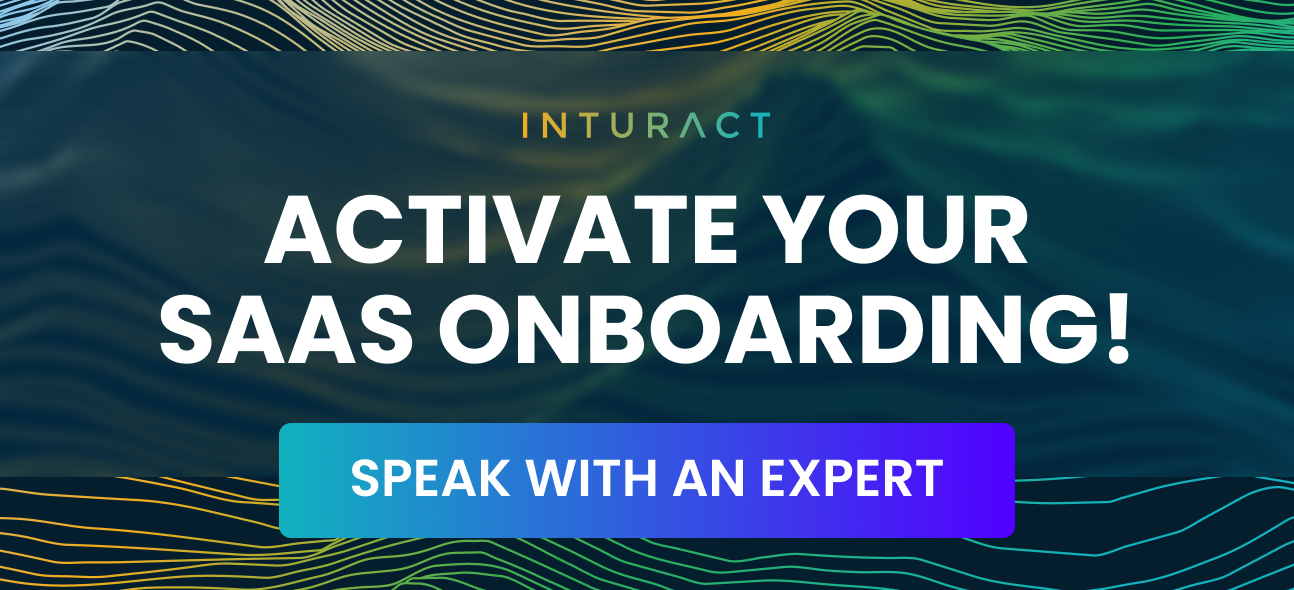Developing a customer onboarding framework is an often-challenging process as it involves taking a holistic view of your client interactions—creating a pipeline that delivers no matter the type of customer or their relationship with your business.
This page covers everything you need to know when creating a customer onboarding framework for the first time. We’ll also cover some tips & tricks that’ll make the process smoother and easier to get to grips with. Let’s dive in!
 Free to use image sourced from Unsplash
Free to use image sourced from Unsplash
What is a Customer Onboarding Framework?
A customer onboarding framework refers to a structured approach implemented by businesses to guide new customers through the initial stages of their journey and a smooth and successful transition into becoming active users.
What does it involve?
Most frameworks adopt a series of planned steps, resources, and interactions designed to educate, engage, and support customers during the onboarding process.
Typically, this includes activities such as product demonstrations, interactive tutorials, self-service knowledge bases, and proactive support.
What are the advantages of such an approach?
A well-defined customer onboarding framework aims to minimize barriers to entry, accelerate user engagement, and foster long-term client relationships. If implemented correctly, customer onboarding should boost satisfaction rates and drive product adoption, laying the foundation for sustainable business success.
What Makes a SaaS Customer Onboarding Framework Unique?
A SaaS customer onboarding framework distinguishes itself from traditional onboarding approaches due to its specific focus on the unique characteristics of SaaS products and the nature of online business models.
Key aspects that set it apart include:
- Scalability: SaaS onboarding frameworks are designed to accommodate a large number of users simultaneously, allowing companies to onboard efficiently and support a growing customer base.
- Self-Service Emphasis: With a self-service approach at the core, SaaS tech stacks empower users to explore and familiarize themselves with the product independently, offering interactive guides, tooltips, and intuitive interfaces.
- Continuous Optimization: SaaS companies regularly analyze user behavior and feedback to optimize their onboarding frameworks, identifying pain points and streamlining the onboarding process to enhance user satisfaction and retention.
- Agile Adaptation: Given the fast-paced nature of the SaaS industry, onboarding frameworks must be adaptable to evolving product features, updates, and user needs, allowing seamless transitions and effective user education during the onboarding journey.
- Data-Driven Insights: SaaS onboarding frameworks leverage data analytics to gain insights into user behavior, enabling companies to personalize onboarding experiences, identify bottlenecks, and make data-backed improvements.
- Customer Success Alignment: Last but not least, SaaS tech aims to align with the broader customer success strategy, focusing on long-term value, customer satisfaction, and ongoing engagement beyond the initial onboarding phase.
By incorporating these elements, SaaS customer onboarding frameworks enable companies to effectively onboard and retain users, driving user adoption, satisfaction, and, ultimately, business growth.
 Image made by writer
Image made by writer
The SaaS Customer Onboarding Framework
Getting started with a SaaS customer onboarding framework involves putting yourself in the shoes of your customers. You should ask yourself questions such as: What will their expectations be at each stage? And how can you make sure that your service will be accessible and intuitive to them?
This section covers a broad chronological process that you can follow:
Onboarding process
The onboarding process involves a clear series of steps to guide users from signup to becoming active and proficient users.
It all begins with a warm welcome—where users are introduced to the product’s value proposition and key features. Emphasizing simplicity and clarity, this initial step should set the tone for the journey.
Configuration and customization
Once users are equipped with core knowledge, the focus shifts to translating it into specific actions. Configuration and customization allow users to tailor the product to their specific needs.
Guiding users through processes such as account setup, payment plan selection, and preference definition is paramount. From customizing settings to integrating third-party tools, this approach empowers users to tailor the SaaS solution to their workflows.
Offering this flexibility cultivates a sense of ownership and control, bolstering user satisfaction and fostering a positive outlook—an essential ingredient for a successful onboarding experience.
Training and education
A robust SaaS customer onboarding framework then prioritizes training and education to empower users with the knowledge needed to leverage the product effectively.
The best frameworks incorporate a variety of onboarding resources to accommodate different learning styles, including but not limited to:
- Video tutorials.
- Step-by-step guides.
- Interactive demos.
By providing comprehensive and accessible educational materials, users can quickly grasp the product’s functionalities, learn the best practices, and unlock its full potential.
Customer support
Prompt and responsive customer support plays a vital role in the SaaS customer onboarding framework—as this lies at the core of what makes users feel supported and valued.
Businesses usually offer several responsive communication channels, such as live chat, email, and phone support. No matter the channel, the aim remains largely the same: to address user inquiries, provide clarifications, and troubleshoot possible obstacles.
To keep on top of these different communication channels, you should use a Customer relationship management (CRM) platform.
What is a CRM platform? This software allows you to organize and track all of your customer’s relations in one place. This allows you to give the best customer support as your team will have the information they need, and they can also track the customer journey to see where issues arise.
Finally, great customer support comes down to keeping your team motivated and empowered. There’s nothing worse than having lots of people ask you questions you don’t know the answer to. Your team will provide the best support when they feel confident that they know how to guide customers and fix the issues they have.
So, use the tools at your disposal, invest in HR software for small businesses and implement staff reward programs. Combining the two will allow you to track staff performance, keep up to date with their training and, crucially, acknowledge all the hard work they put in to keep your customer onboarding running smoothly.
Milestone tracking and progress evaluation
Progress evaluation is another integral component of a SaaS onboarding framework. By setting clear milestones and objectives, users can measure their progress and perceive tangible value from the product.
The framework may incorporate progress trackers, achievement badges, or personalized progress reports to highlight users’ advancements. These visual indicators not only motivate users but also provide valuable insights for the onboarding team to assess user engagement, identify bottlenecks, and optimize the onboarding process continuously.
Feedback collection and iteration
Continuous improvement is key to any type of customer onboarding framework, and feedback collection plays an especially vital role to achieve this.
By actively seeking customer insights through surveys, interviews, or feedback forms, businesses can visualize how their product appears to users—identifying pain points and suggestions for enhancement.
Iterative improvements make sure that the onboarding experience remains relevant, user-centric, and aligned with evolving user needs and expectations. To streamline your continuous development, you should implement these objective cycles into your Enterprise Resource Planning (ERP) solution.
What is an ERP? An ERP is a type of software that allows for the integrated management of day-to-day business operations. It’s particularly useful when it comes to implementing new processes because by using ERP, you get a full overview of all your business data. Allowing you to monitor the development of the project and view customer data all in the same platform.
Image made by writer
Post-onboarding Stage
The customer journey doesn’t end as soon as you make a sale. After all, a huge source of ecommerce revenue comes from name recognition via brand image and the repeat business that follows.
This section covers the steps you should follow to encourage customers to return to your site, make further sales, and, hopefully, become brand ambassadors for your business.
Continuous engagement and nurturing
The post-onboarding stage within a SaaS customer onboarding framework is dedicated to fostering continuous engagement and nurturing relationships with users.
This involves implementing strategies to keep users actively using and deriving value from the product. Personalized communication, targeted campaigns, and relevant content are deployed to maintain user interest and encourage further exploration.
Furthermore, by leveraging user behavior insights, businesses can deliver tailored experiences, highlight advanced features, and provide ongoing value for long-term customer satisfaction and retention. Continuous engagement efforts help solidify the relationship, increase customer loyalty, and pave the way for upselling and expansion opportunities.
Ongoing support and upselling opportunities
Ongoing support is a crucial aspect of the post-onboarding stage because it presents valuable opportunities for upselling and expanding product usage. By identifying users’ evolving needs, businesses can strategically offer additional features, upgraded plans, or complementary products to drive customer growth and increase revenue.
In short, proactive communication plays a key role in capitalizing on upselling opportunities and nurturing long-term customer relationships.

Image sourced from smile.io
Evaluation and refinement of onboarding framework
Continuous evaluation and refinement of the onboarding framework are essential to guarantee its effectiveness and adaptability.
Feedback collection, user surveys, and data analysis provide an insider perspective into the onboarding experience and user satisfaction. By gathering feedback from users, businesses can gain a much clearer view of bottlenecks and areas for improvement, thus presenting opportunities to optimize the onboarding process further.
Taking a sustained approach enables companies to reflexively change onboarding materials, streamline processes, and enhance user engagement. The evaluation stage also allows for aligning the onboarding framework with evolving product features, user needs, and industry trends, ensuring it remains relevant and impactful in driving user success and business growth.

Free to use image sourced from Unsplash
Streamline your Customer Onboarding Framework
To conclude, customer onboarding processes can boost your company’s reach, convert more site visitors into paying customers, and encourage brand loyalty.
A customer onboarding framework for SaaS is really no different—it only involves adapting this process for a new type of target audience and providing the necessary resources at each step. When getting started, it’s a good idea to follow these tried-and-tested tips:
- Understand your users: Conduct user research, gather extensive feedback, and analyze user behavior to inform the development of your framework.
- Define clear onboarding goals: Identify key milestones and metrics that indicate successful onboarding, such as user activation, feature adoption, or time-to-value.
- Prioritize simplicity and personalization: Design your onboarding experience to be intuitive, streamlined, and user-centric. Don’t forget personalized touches to deliver a positive first impression.
Do this, and you’ll be within arms reach of a customer framework that delivers recurring value and increased exposure to your brand. Good luck, and enjoy the process!
- SEO Powered Content & PR Distribution. Get Amplified Today.
- PlatoData.Network Vertical Generative Ai. Empower Yourself. Access Here.
- PlatoAiStream. Web3 Intelligence. Knowledge Amplified. Access Here.
- PlatoESG. Automotive / EVs, Carbon, CleanTech, Energy, Environment, Solar, Waste Management. Access Here.
- BlockOffsets. Modernizing Environmental Offset Ownership. Access Here.
- Source: https://www.inturact.com/blog/what-is-a-customer-onboarding-framework-for-saas




